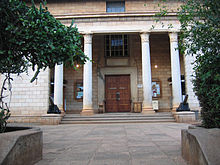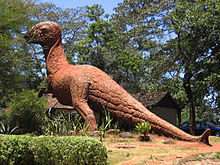- National Museums of Kenya
-
The National Museums of Kenya (NMK) is a State Corporation that manages Museums, Sites and Monuments in Kenya. It also practices scientific research. Its headquarters and the National Museum (Nairobi National Museum) are located on Museum Hill, near Uhuru Highway between Central Business District and Westlands in Nairobi. The NMK was founded by the East Africa Natural History Society (E.A.N.H.S) in 1910; the Society's main goal was and is to conduct an ongoing critical scientific examination of the natural attributes of the East African habitat. The museum houses museum collections and exhibits, both temporary and permanent exhibits. Today the NMK manages over 22 regional museums, many sites, and monuments across the country.[1]
Contents
Nairobi National Museum
Natural History Museum
The East Africa and Uganda Natural History Society was founded in 1910-11 by persons with an interest in nature in British East Africa.[2] The group included two canons of the Church Missionary Society: Rev. Harry Leakey (father of Louis Leakey) and Rev. Kenneth St. Aubyn Rogers; some government officials: C. W. Hobley and John Ainsworth, doctors, dentists, big-game hunters and plantation owners. In 1911 they established the Natural History Museum and library with an honorary curator. Aladina Visram put up the money for a one-story, two-room building.[3]
In 1914 they could afford a paid curator. They brought in Arthur Loveridge, a herpetologist, who arrived in March, 1914. Loveridge concentrated on collections, with the members volunteering to contribute specimens, labor and funds. They also ran the museum while Loveridge fought for the British in German East Africa. He returned for a brief stay after the war, only to go to America, where he eventually became a Harvard University professor.
Coryndon Museum
The next curator was A. F. J. Gedye. The museum moved to a new building at the corner of Government Road and Kirk Road. Among the new volunteers for the society were Sir Robert Coryndon, Governor of Kenya. At his unexpected death in 1927 Lady Coryndon established the Coryndon Memorial Fund to build a better museum for the society in memory of her husband. The government offered matching funds for public donations and in 1928 construction began.
The building was ready in 1929 but unfortunately no workrooms or storage space had been provided and therefore the Natural History Society declined to move in. The government then bought the old museum and the society used the money to add three rooms, gave its collections to the museum trustees, but retained the library. Everything was moved to the museum. Lady Coryndon donated Sir Robert's books to it.
The museum was officially opened on September 22nd 1930, as Coryndon Museum, with Victor Van Someren, a member, as curator. He was given a house on the grounds. When the relationship between the museum trustees and the society became problematic, the two organizations appointed a committee including Sir Charles Belcher, a Kenyan jurist, to stabilize it. The committee turned everything over to the museum except for the library in exchange for annual payments for 15 years to the society.
The museum now had a staff. Mary Leakey became part of it and then Louis Leakey, as unpaid curator, in 1941. He stepped in when Dr. van Someren resigned after the board (including Louis) refused to fire Peter Bally in a personality conflict. The museum was a center for Leakey operations. In 1945 Louis was hired as paid curator with a new house, as the old one had become run-down. He built up the exhibitions and opened them to Africans and Asians by lowering the admission fee. Prior to then the museum had been "for whites only."
The museum was a base for Leakey operations until 1961, when Louis founded the Centre for Prehistory and Paleontology on the grounds nearby and moved himself and his collections to it. He resigned in favor of the next director, Robert Carcasson.
National Museum
Kenya became independent in 1963. The Coryndon Museum was renamed "National Museum" in 1964 and was included in a new system, the "National Museums of Kenya." In 1967, Richard Leakey, was having irreconcilable differences with Louis Leakey, his employer in the Centre, and decided to improve the National Museum. His main objection was that it had not been Kenyanized. He and supporters formed the Kenya Museum Associates, which obtained an observer's seat for Richard on the board from Carcasson in exchange for a 5000-pound contribution. Richard did not do much observing, as he departed for the first Omo expedition.
The Kenya Museum Associates included Joel Ojal, the museum overseer in the government. On his return from Omo Richard gave his ideas for improvement directly to Joel, who asked the chairman, Sir Ferdinand Cavendish-Bentinck, to place Richard in a senior position and begin replacing the board with Kenyans of Kenyan extraction, as there were only two out of 16 in that category. The penalty for inaction would be removal of government funding.
Richard was at first offered a part-time executive position, which he turned down. Over the next few months much of the board was replaced and in May 1968 the new board offered Richard a permanent post as administrative director, with Carcasson to be retained as scientific director. However, Carcasson resigned and Richard became director.
Gallery of Kenyan Tribes
This gallery contains artwork by Joy Adamson featuring various Kenyan tribes in traditional attire.
Modern events and facilities
On October 15, 2005, Nairobi Museum Galleries temporarily closed its doors to the public for an extensive, two year rebuilding program until December, 2007. The ambitious expansion and improvement program was intended give Nairobi Museum a major facelift and transformation into a world-class tourist destination. This was the first major renovation since 1930. Other key developments include the building of a new administration block and new commercial center, and improving NMK's physical planning.[4]
The Nairobi National Museum re-opened its doors to the public in June 2008, refurbished with a new look. The museum houses both temporary and permanent exhibitions to ensure it remains vibrant and interesting. [5]
Other attractions within the grounds include the Nairobi Snake Park and the Botanic Garden and nature trail. The museum's commercial wing has restaurants and shops to ensure a memorable and wholesome experience.
Other museums
Other museums, sites and monuments operated by the NMK, including eco-tourist attractions are:
- Nairobi Gallery, Nairobi
- Uhuru Gardens, Nairobi
- Institute of Primate Research, Nairobi
- Fort Jesus, Mombasa
- Gedi ruins, Gedi, near Malindi
- Hyrax Hill, near Nakuru
- Jumba la Mtwana, Mtwapa, near Mombasa
- Kabarnet Museum, Kabarnet
- Karen Blixen Museum, Nairobi
- Kapenguria Museum, Kapenguria
- Kariandusi Museum, near Gilgil
- Kisumu museum, Kisumu
- Kitale Museum, Kitale
- Koobi Fora, at Sibiloi National Park
- Lamu Museum, Lamu
- Meru Museum, Meru
- Mnarani ruins, Kilifi
- Narok Museum, Narok
- Olorgesailie, near Magadi
- Siyu Fort, Pate Island
- Takwa ruins, Manda Island
- Thimlich Ohinga, 45 km west of Migori
Notes
- ^ NMK, "National Museums of Kenya," 2006-03-31, Museums.or.ke, web: MuseumsOR
- ^ It descended to the East Africa Natural History Society, an international organization with outlets in a number of countries. In Kenya it is Nature Kenya.
- ^ This section relies heavily on L. S. B. Leakey, By the Evidence: Memoirs, 1932-1951, Chapter 8.
- ^ NMK, "National Museums of Kenya - Museum in Change," 2006-03-31, Museums.or.ke, web: MuseumsOR-redo
- ^ NMK, "National Museums of Kenya - Museum in Change," 2006-03-31, Museums.or.ke, web: MuseumsOR-redo
External links
Categories:- Museums in Kenya
- Natural history museums
- National museums
- Buildings and structures in Kenya
- Nairobi
Wikimedia Foundation. 2010.


